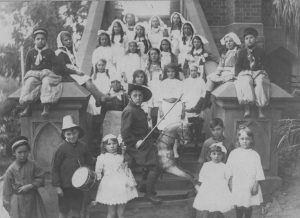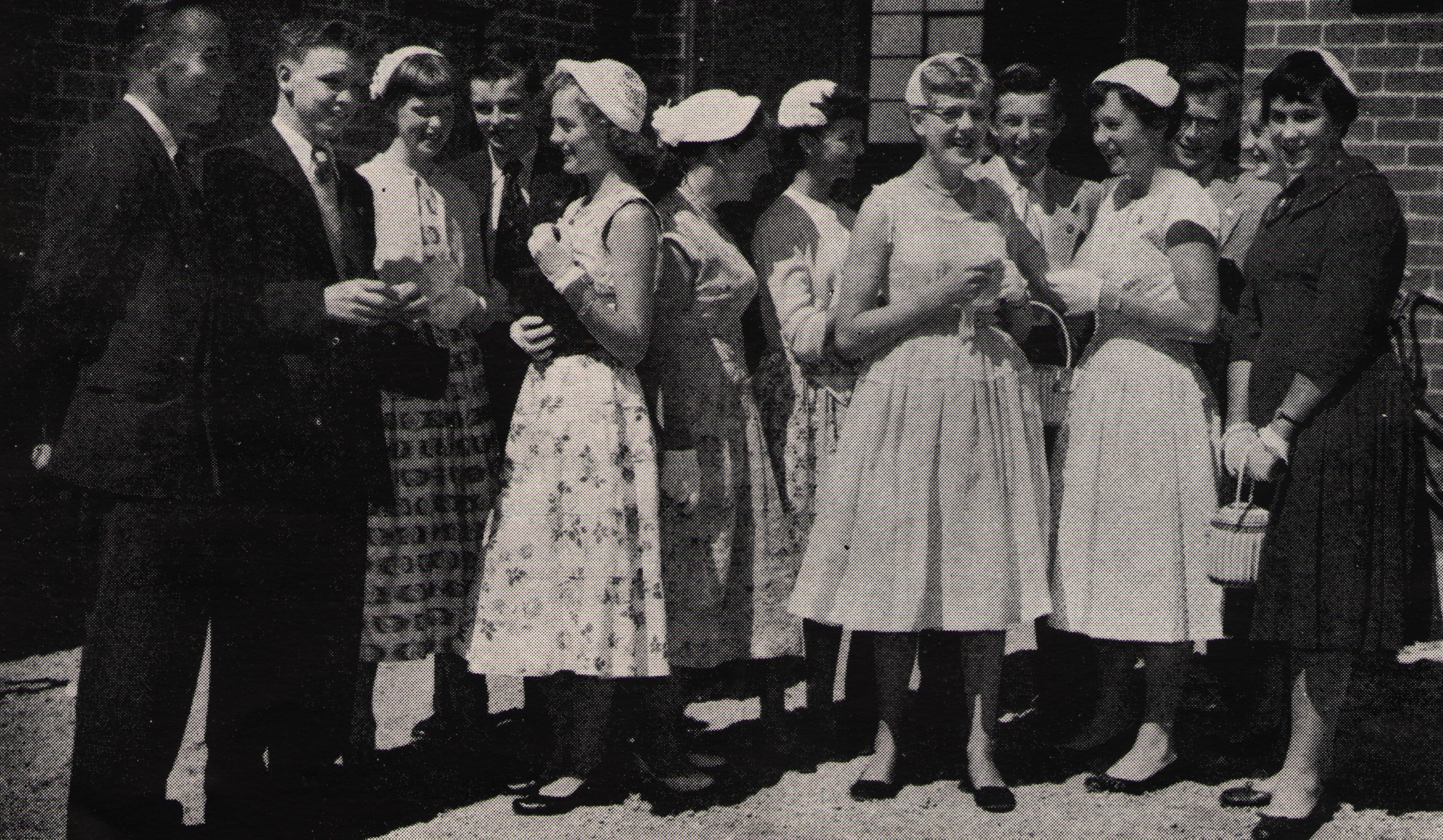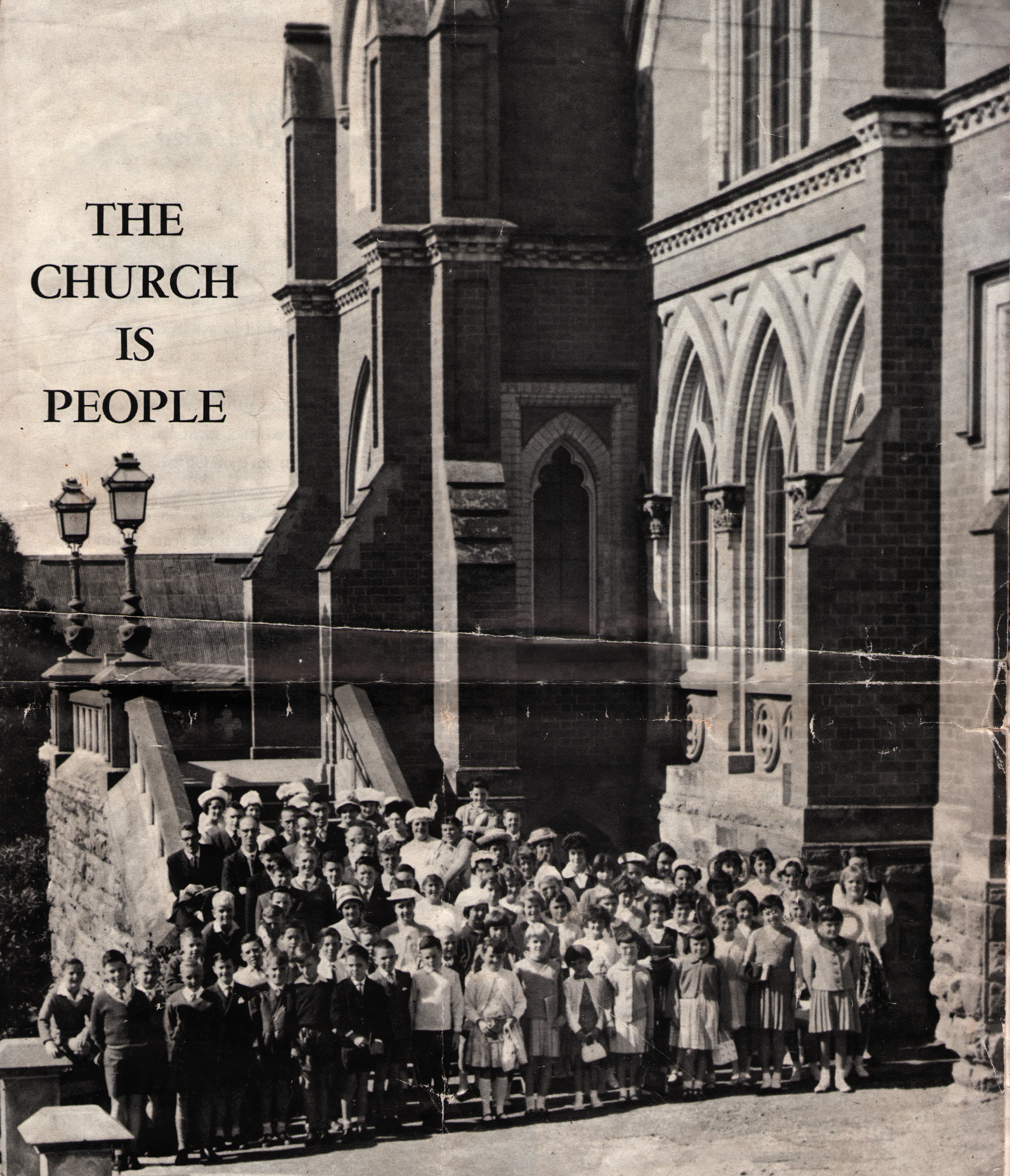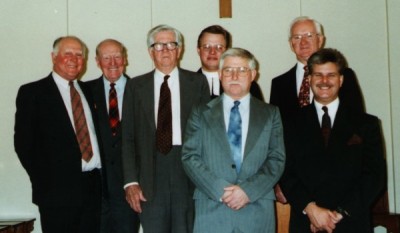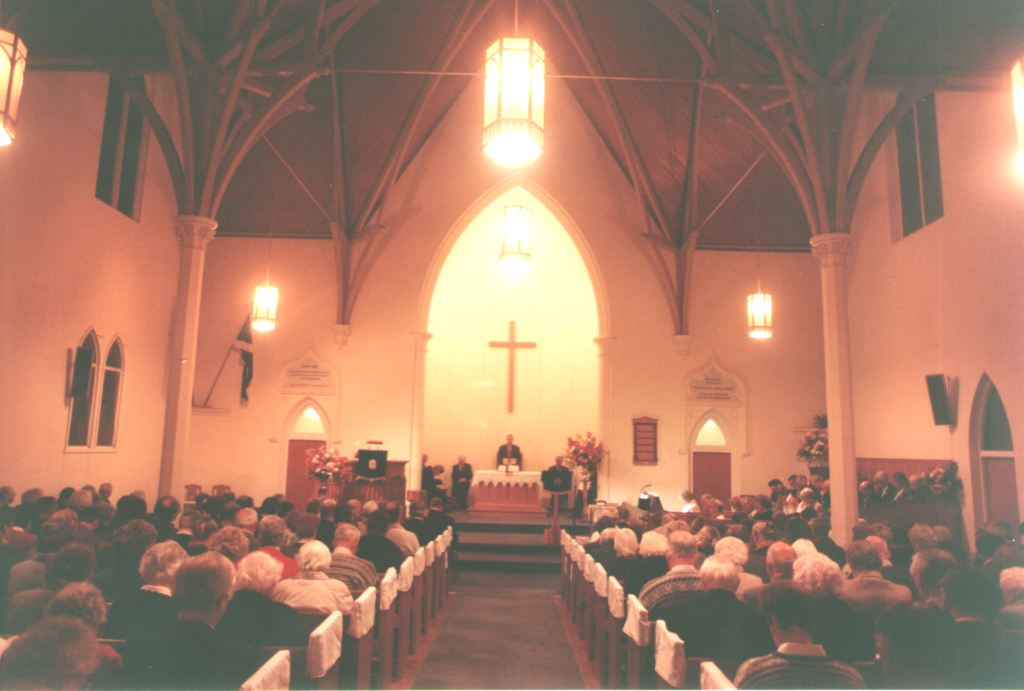
 Yep it’s true! Here’s a fuller account of our history that may explain how it happened and why….!
Yep it’s true! Here’s a fuller account of our history that may explain how it happened and why….!
Many of the first settlers in Bendigo were miners who had come to the goldfields in search of their fortune and escape the appalling working conditions in the Welsh mines, or those in Ireland or the cotton mills of Northern England. In 1852, Wesleyan local preachers from Wales had begun tent services at Golden Square, the Roman Catholics likewise met in a tent in McCrae Street and the Church of England also met in a tent in View Street.
Among the settlers were also several well educated Scotsmen who longed for Presbyterian worship as they knew it in their homeland. One such man was Dr Edward D. Allison who was responsible for the following announcement in ‘The Bendigo Advertiser’ of 3rd January, 1854. It read: To the Presbyterians of Bendigo: a meeting of Presbyterians will be held in the English Chapel (Rev. McGregor’s) View Point, on Sabbath Evening 8th instant, at half-past five o’clock precisely, to consider the best means of providing worship regularly, according to the forms of their Church. All persons desirous to progress and diffuse the principles of pure Presbyterianism are respectfully invited to be present. Several gentlemen will address the Meeting. A collection (which it is hoped will be liberal) will be made at the close of the proceedings to defray preliminary expenses.
At an adjourned meeting on the following Sunday Dr. Allison announced that a large sum had been received in subscriptions for a suitable place of worship. The following month, a Smithy, situated in what is now Bridge Street, was purchased and became the first Presbyterian place of worship in Bendigo. The building was constructed of slabs with a calico roof. the seats were made of rough pieces of wood driven two feet into the ground to keep them steady, with course slabs nailed on top of them with no backs. The building was also used as a day school for the education of Presbyterian children. This was the humble beginning of the Presbyterian Church in Bendigo, as it set out establish itself on the goldfields.
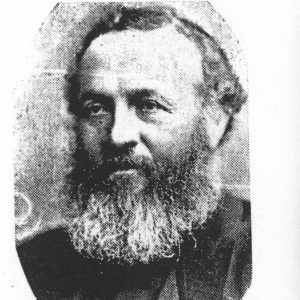 The Rev. James Nish (left), a young man of 29 who had recently arrived from Scotland, was appointed the first Minister of the newly formed Congregation. He arrived in Bendigo on 24th August, 1854. The first Presbyterian Church building (St. Andrew’s), built in early English Gothic style was opened and dedicated for worship on 19th January 1859. (The next was the Eaglehawk Church which was the first ‘church plant’ from St. Andrew’s in 1860.)
The Rev. James Nish (left), a young man of 29 who had recently arrived from Scotland, was appointed the first Minister of the newly formed Congregation. He arrived in Bendigo on 24th August, 1854. The first Presbyterian Church building (St. Andrew’s), built in early English Gothic style was opened and dedicated for worship on 19th January 1859. (The next was the Eaglehawk Church which was the first ‘church plant’ from St. Andrew’s in 1860.)
Extracts from the Minutes of Presbytery of Castlemaine on 2nd July 1872, heard a report concerning Presbyterian worship in Bendigo reporting that services would still be well attended if a second Presbyterian Charge was established. Presbytery then resolved to apply to the Home Mission Committee for a grant not exceeding twenty pounds to meet the expense of such services as maybe necessary to test the practicability of establishing that second Charge in Sandhurst.
In September 1872, Messrs. McIntyre, Rae, Purcell, Browne and Small appeared as a deputation relative to the establishment of this Charge. Curiously, Messrs. McIntyre, Rae, Browne and Small all shared the first name John! They stated that services had been conducted for several Sabbaths, that they had been well attended and that the collections obtained at them had been liberal, and they submitted a Memorial signed by 104 members and adherents who expressed their desire to be recognised as a Congregation.
It was agreed that the Prayer of the Memorial be granted and that in accordance with a suggestion made by the deputation, the new Charge should be known as the Congregation of St John’s. Mr. McCoy was appointed to take the Interim superintendence of it as Moderator, and Dr. White and Mr. R. Gordon to act with him as Assessors.
The first Service was conducted on the 8th September of that year by Rev. P.S. Menzies, M.A. with services held at the Rifles Orderly Room (Site of Art Gallery), and afterwards at the Albion Hall (Site of The Royal Princess Theatre, on corner of Mackenzie and View Streets). The Pulpit was at first supplied by Ministers from Melbourne until the Rev. R. Lewers (Robert) was inducted on 1st May, 1873, into the Charge known as St John’s Presbyterian Church. Upon his arrival the Congregation was obliged to meet at St. James’ Hall in Williamson Street (now owned and occupied by Myers as the site of the Albion Hall was required for the erection of the Princess Theatre). A bazaar was held by the St John’s Congregation and the sum of £700 realised. With this a weatherboard church was built in Forest Street. It was erected in 1874, with seating accommodation was afforded for about 550 persons.
Owing to financial difficulties, St John’s was taken over by Mr. John Rae (Uncle of Mrs. W. Anderson), one of the Trustees. As Rev Lewers had accepted a call to Eaglehawk, Mr. Rae invited the Rev. T.E. Ick, M.A, to take charge. Although he was not associated with the Presbyterian Church, Rev. Ick accepted the invitation. This led to a serious division in the congregation resulting in a section breaking away and engaging the Masonic Hall, with Rev. W.G. McDonald as Pastor in 1878. This section of the Church must be considered to be the congregation of St. John’s Presbyterian Church.
The Forest Street Church became known as St John’s Free Presbyterian Church, and in 1880 it was admitted into the Presbyterian Church of Victoria and its name altered to Chalmers’ Church or Chalmers’ Presbyterian Church. This section of the Church decided to build a Church for themselves. The Foundation Stone of a new Brick Church in Rowan Street, called St John’s Presbyterian Church was laid on 1st September, 1880, by the Rev Dr McDonald of Emerald Hill. The Church when built had seating for 300 and was on the corner of Rowan and Richard(?) Streets.
In the Foundation Stone was placed a bottle containing a parchment on which was written the names of the Minister, Committee, Architect, and Contractor of the Church, copies of the Bendigo, Advertiser, Independent, and Evening News. The Church was made of brick, with cement facings. Its dimensions were 45 feet by 30 feet. There was one large Gothic window in front, and four small ones on each side. Mr. W. C. Vahland was the Architect; and the amount of the contract for the work was £450. The Church afforded seating accommodation for 200 to 250 persons.
In 1882 the Pastor of the Rowan Street Church, the Rev. W. G. McDonald, B.A., resigned the Charge, and the Congregation became associated with St. Andrew’s Church in Myers Street. Mr. Talbot assumed the duties of a resident Minister, preaching at Axedale and St John’s, and changing places with Dr Nish the evenings, when he preached in their new brick Church.
Meanwhile at St John’s Free Church in Forest Street, it was recorded that a small though excellent organ was in use by the Congregation. There was a thriving Sabbath School in connection with the Church, of which the Minister, the Rev. Thomas E. Ick, M.A., was the Superintendent, and Mr John Gray the Secretary. A weekly Bible Class was also held by the Minister, especially for the benefit of the younger portion of the congregation.
In 1884, Rev. Ick left Chalmers’ Church for Albert Park and Rev. V. M. Riordan was inducted, but on February 12th, 1885, Chalmers’ Church was destroyed by fire; the origin being unexplained. It was a large wooden building, and the reflection was seen for miles around. One very good result of the fire was that it led to the two sections of the original St John’s being reunited.
In 1886 the Rev. J. Hunter Potter became the Minister of the re-united Church. It became known as The West Sandhurst Presbyterian Church with services held in the Rowan Street Church. After financial difficulties which persisted for some years, it was resolved to sell the Rowan Street property and build a new church in Forest Street, the original “home” of St John’s, and this was undertaken.
The Opening Services of the new St John’s Presbyterian Church were held on 4th July, 1897. The services were conducted by the Rev. J.H. Mackay who had become the Minister of the Church, and the Rev. A.S.C. James. The Architects of the new Church were Messrs. Vahland and Son, and the contractors, Messrs Fairbanks and Wilson. The building was built in the Gothic style to accommodate 400 persons. It was lighted by 18 windows at the sides and two large five feet rose windows at each gable.
Worship continued in this building until 1949 when plans were in hand for the demolition of the church and the erection of a third church building on the same site when an offer to purchase the former Congregational Church (on the corner of Forest and Mackenzie Streets) arose. Special meetings of the Board of Management in consultation with the Architectural Committee of the PCV in Melbourne, agreed that the purchase of this building for 2,500 pounds was an opportunity to be grasped. A Congregational meeting approved the purchase of the building and the block of land adjacent to it. Estimates for the alterations required came to an additional 2,500 pounds. In order to finance this, a loan of 4,000 pounds was sought from the Grants and Loans Committee of the PCV and the sale of the wooden church building assisted in the purchase. Most of the alteration and renovation work was carried out by church members over a 2 year period. The site has been used for worship alsmost since the beginnings of Bendigo, given that the first church on this site was built in 1858. The details of this building (which is still our present place of worship!) are as follows;
“The Congregational Church at the corner of Forest and Mackenzie Streets, was erected from a skilful design of a Gothic Type by Mr. W.C. Vahland, in the year 1890 at a cost of 2,481 pounds, which replaced an earlier building of an unpretending character, which was reared in 1858 (and opened on 28 November) that is to say, in Bendigo’s infancy, when this religious body first organised itself into a Congregation under the ministry of Rev. Mark Butler. The first Congregational service in Bendigo was held on 30 May 1858, conducted by Rev W Robey Fletcher.” The church built in 1890 was utilized as a School Room in 1902, but many fond memories gather round it in the minds of those who first assembled for worship within its walls.”
The new St John’s was opened and dedicated on Saturday September 8th 1951 by the Rev J. Edward Smith assisted by the members of the Presbytery of Bendigo. This was one of the great highlights of that era in the life of St John’s. Numerous gifts of furnishings and equipment were dedicated at this service. After Rev Smith’s ministry concluded in 1952, Rev D. G. McKenzie became the Minister and work began on the erection of the Sunday School Hall that year. Working bees over a three year period saw the task completed. During the time of construction the Sunday School was held in the old A.N.A hall in View Street and the Kindergarten was held in the Forest Street Manse.
Churches flourished in Australia in the 1950’s and Stewardship Campaigns were common. The first held at St John’s was under the leadership of the Rev J. W. Beecher in 1956 and this greatly facilitated the consolidation of the Church’s financial position. The finial on the spire which surmounts the building’s unusual tower, was added in 1958 following a gift from Mr & Mrs T S Fleming.
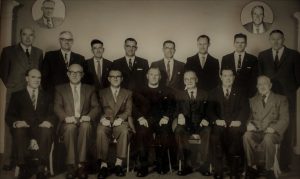
St John’s Session 1960 L-R: Dr K Kerr, L Shepherd, B Williamson, J Kitt, K Hesse, W Quirk, R Mellis, V Smythe, A Scholes, A Fraser, G Ricketts, Rev J Beecher, W Mellis, R Wilmot, T Fleming. Inset: H Allen, F Hesse
During the 1960’s the St John’s congregation grew and expanded in many ways. An extra communion service was introduced in 1967 and morning service time was changed to 10am in 1968. The Choir , the Sunday School (average attendance 80 children), the Ladies Auxiliary (formed 1962), the Afternoon PWMU, the Evening Fellowship (formed 1953), the Ladies’ Guild (formed 1908) , the PFA, the Men’s Club and Brotherhood, the Bible Class and Mission Band were all vital aspects of the Church’s weekly activities. Alongside these groups which encouraged the spiritual life of the congregation, there was also an active Tennis Club (formed in 1925), a Cricket Club, Badminton teams, Basketball teams, a Calithsenics Club (1964-65) and a Ladies’ Bowling Club.
By the mid 1970’s talk of Church Union (the merger of the Presbyterian, Methodist and Congregational churches) was gathering momentum. Combined services with the Wesley Methodist Church in Forest Street were customary on the evening of the 3rd Sunday of the month and during January. When eventually the vote relating to Church Union was held, the result was the St John’s congregation became part of the Uniting Church and the building was also awarded to the Uniting Church. Those members of St John’s who wanted to unite continued to meet for worship at St John’s and also down the road at the ‘new’ Uniting Church (formerly the Forest Street Wesley Methodist Church).
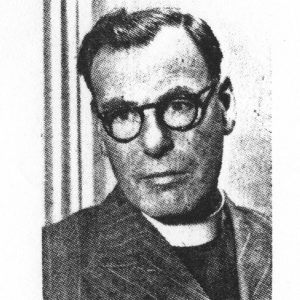 Meanwhile those who were not in favour of the merger and wanted to remain ‘Presbyterian’ worshipped at the Eaglehawk Presbyterian Church, which had been awarded to the continuing Presbyterians, under the care of the Rev. John Aitken (left) who served this congregation, alongside of his wife, Elsie until March 1980, when the Aitkens moved to Geelong for retirement. For more about John and his ministry, see the footnote below. He entered the presence of his Master on 12th May, 1985, with his funeral held at St George’s Geelong.
Meanwhile those who were not in favour of the merger and wanted to remain ‘Presbyterian’ worshipped at the Eaglehawk Presbyterian Church, which had been awarded to the continuing Presbyterians, under the care of the Rev. John Aitken (left) who served this congregation, alongside of his wife, Elsie until March 1980, when the Aitkens moved to Geelong for retirement. For more about John and his ministry, see the footnote below. He entered the presence of his Master on 12th May, 1985, with his funeral held at St George’s Geelong.
Meanwhile, the first Presbyterian service in Bendigo after Union was held on June 26, 1977 with over 100 people attending and the Eaglehawk church packed. During this time, the St John’s building was owned by the Uniting Church and used for occasional services and later leased to a local Assemblies of God on a regular basis.
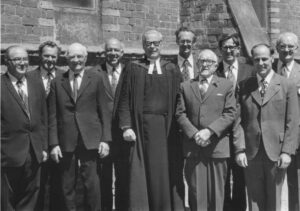
Bendigo Presbyterian Church Session 1978: L-R: Jim McKinty, Barry McArthur, Andy Williamson, Ian Nixon, Rev John Aitken, Ernie Stone, Tom Fleming, Dr Bill Purton, Herb Stephens, Ron Twitt
With the ‘Bendigo Presbyterian Church’ now meeting at Eaglehawk, Rev Colin Harrison (1980-1983) succeeded Rev John Aitken and then the Rev John Webster (1985-1995) was called to serve as the Minister. Under the time of John’s leadership, those who had come from St John’s still retained a vision to see Presbyterian worship return to central Bendigo again and held onto a distant hope of buying back the St John’s building. It was with this in mind that Presbyterian services were resumed at the All Saints Anglican Church in Forest Street on January 10th 1982 on a weekly basis, with the St John’s congregation formally created again as a preaching place alongside Eaglehawk. The ‘distant hope’ became one step closer in March 1985 when a meeting of the congregation (19 people) held in the All Saints Church meeting room, agreed to put in an offer for the Forest Street building. Although this offer was rejected, a further offer was finally accepted and the building purchased for $145,000 and the building (once Congregational, then Presbyterian, then Uniting) once again became a Presbyterian Church.
The building was eventually re-opened and re-dedicated as St John’s Presbyterian Church at a service on October 6, 1985 at a service that commenced at 3pm (and went until 4:30pm!) to an estimated congregation of 450 with many seated in the hall watching the service on a relay. Afternoon tea followed in the hall. The service was led by the Moderator of the Presbytery, Rev Dr John Muller, the offical opening conducted by the Moderator of the PCV, Rt Rev Arthur Stamp, and the preacher for the occasion was Rev Prof Allan Harman whose sermon was titled ‘Glory to God’.
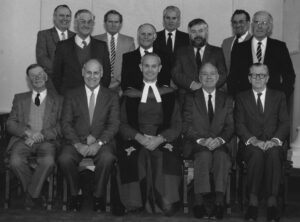
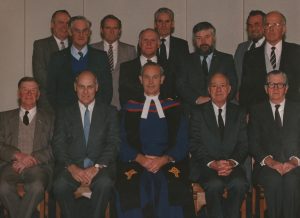
The Session of Eaglehawk & St John’s in June 1991. Back L-R: John Senter, Barry McArthur, Leo Reither, Lindsay Stephenson. Middle L-R Ernie Stone, Bill Gray, Dr Jim Thompson, Vic Upson. Front L-R: Lou Dennett, Herb Stephens, Rev John Webster, Ian Nixon and Dr Bill Purton
Following the departure of the Rev John Webster to Newcastle (NSW) , a young exit student was appointed to St John’s after completing his studies at the Presbyterian Theologicical College in Melbourne, and soon Andrew Clarke (1995-2005) was called, ordained and inducted. Thus the St John’s congregation grew under the ministry of Rev Andrew Clarke (1995-2005). Andrew came as an exit student and was ordained and inducted as Minister of the Eaglehawk and St John’s congregations. He came as a single man, but eventually married his cherished, lifetime friend Simone.
The Session of St John’s in November 1995 L-R Bill Gray, Jack Boland, Dr Bill Purton, Rev Andrew Clarke, Robert Taylor, Ron Twitt and Graham Cowcher
Significantly, during these years, the St John’s congregation separated from the Eaglehawk congregation and became a Full Charge (as in, financially independent) once again, while Eaglehawk became a Home Mission Charge (as in, in continuing need of financial aid). Andrew was inducted as the Minister of St Johns on May 1st, 1998.

Andrew (centre) flanked by his parents with the Mayor, Maurie Sharkey, Rev Dr Allan Harman (L), Rev Ted Pearsons and Rev John Woodward (R)
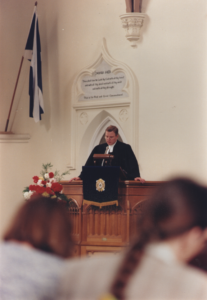
Rev Andrew Clarke preaching God’s Word
When Andrew accepted a call to the North Toowoomba Charge in 2005, St John’s was cared for by the Interim Moderator, Rev John Wilson, the Clerk of the Presbyterian Church of Victoria. Under John’s leadership, the congregation issued a call to Rev David Schultz of the Tatura Charge, but this was declined. However, another call to Rev Philip Burns, who was the Associate Minister of St John’s, Warrnambool, was accepted and Philip was inducted to St John’s on March 2nd, 2007 and moved into the manse with his wife Sandra, and the two youngest of their 4 children. Philip’s ministry received a huge boost when Russ Grinter came from Wagga Wagga to Bendigo at the start of 2008 to work on the La Trobe University campus as the AFES Staff worker and soon joined St John’s. Russ also brought with him two members of his support team in Drew & Esther Kerr, who quickly established themselves within the St John’s Church family and became an integral part of it. Drew was ordained and inducted as an elder at St John’s in March 2012 and Russ (after marrying Aimee) in October 2012.
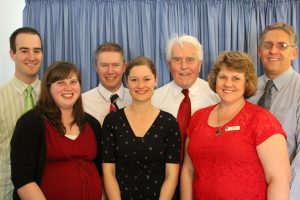
(Picture: Members of the St John’s Session (and their wives) in October 2012. Rear L-R: Andrew Kerr, Russ Grinter, Rev John Sutherland, Rev Philip Burns. Front L-R: Mrs Esther Kerr, Mrs Aimee Grinter and Mrs Sandra Burns)
While Philip introduced some changes to the style of worship at St John’s through the formation of a music team and the introduction of some more modern worship songs, some other some significant developments began to take place with the internal renovations on the Church Hall (completed in October 2012) which brought about the comfort of indoor toilets and the practicality of a large, functional kitchen.
Even better than that, perhaps the most significant development and perhaps our greatest achievement to date, has been the planting of a new congregation in South East Bendigo known as ‘Reforming’ (South East Bendigo Presbyterian Church) which began meeting together in February 2013 under Russ Grinter’s care. Russ had become a candidate for the ministry and completed further studies at the Presbyterian Theological College and was then appointed as an exit student to Reforming where, in time, he was called, ordained and inducted in December 2014. (Reforming is now known as the Bendigo East Charge given that they were able to purchase a very suitable property – with thanks to God – in Victa Road, East Bendigo.)
And so in summary….since 1872 in Bendigo, there have been four Presbyterian Churches named St John’s (that is, Church buildings).
The four churches are;
1. Forest Street, wooden, built in 1874.
2. Rowan Street, brick, built in 1880.
3. Forest Street, wooden, built in 1897 (pictured above).
4. Forest Street (the present Church) on the corner of Forest & Mackenzie Streets.
And the St John’s congregation has met in eleven places of worship!
The eleven places of worship are;
1. Orderly Room in View Street, Bendigo
2. Albion Hall in View Street, Bendigo
3. St James’ Hall in Williamson Street, Bendigo
4. The first St. John’s Church in Forest Street, Bendigo
5. Masonic Hall in View Street, Bendigo
6. The second St.John’s Church in Rowan Street., Bendigo
7. The third St. John’s Church in Forest Street, Bendigo
8. The fourth St. John’s Church (our present building).
9. Eaglehawk Presbyterian Church in Victoria Street, Eaglehawk.
10. Wesley Methodist/Uniting Church in Forest Street, Bendigo
11. All Saints Cathedral in Forest Street, Bendigo
Throughout the almost 150 years of its existence, the St John’s congregation (like almost all congregations) has had its ups and downs, trials and tribulations and yet has known times of great blessing and the unmerited favour of the Lord. And now, thanks be to God, the current congregation is alive and well and keen to do what it can to be a ‘light on the hill’ to the city of Bendigo through the proclamation of the glorious gospel of His Son, the Lord Jesus Christ.
Acknowledgement: The information on this page came from a document in our church archives, thanking Mr Len Bennetts for part of that which has been recorded while also acknowledging that the bulk of the information came from investigations carried out by Mr. Alex Hepburn Stone, in July 1972. Extra information has come through newspaper clippings and orders of service kept and supplied by Mrs Geraldine Mitchell and a 76th Anniversary booklet supplied by Margaret Walker.
Footnote: The following tribute was prepared by the Session of St George’s Church, Geelong, on the 28th of November 1982 to congratulate Rev John Aitken upon the completion of 50 years of active ministry.
“Born in Scotland. Reverend John Aitken came to Australia with his parents, who took up farming at Bellendella near Rochester in northern Victoria. After leaving the small rural school, he worked on the farm until the age of 21, when he felt the call to study for the ministry. He faced the challenging task of completing secondary education to enable him to qualify to undertake a university course. With this achieved, he entered Ormond College in 1926 for six years of study, and graduated in 1931 with a Bachelor of Arts and a Bachelor of Divinity. in 1932 he was appointed to St John’s Hobart, and in that December was Ordained and inducted. His dedicated approach and inspirational leadership enabled him to render faithful and appreciated service in the areas where he has served: three and a half years in Hobart, two years in Scotland, three years at Glen Iris, six years at Ross Memorial Church, Perth and 19 years at St Andrews Bendigo, from 1946 to 1965. In 1966 he undertook supply appointments at Mount Gambier and Kerang, followed by five years at Lorne. In 1973 he moved to Bendigo and became Assistant Minister at St Andrews until church union took effect in 1977. When all the Presbyterian churches in Bendigo became Uniting. John took up the challenge of forming a Presbyterian Church again, and with the help of loyal, devoted members, he worked zealously and tirelessly from 1977 to 1980 to establish a church at Eaglehawk, which has become a sound and expanding witness for the Presbyterian Church in the Bendigo area. When the need at St George’s, Geelong need became known, John was invited to supply St George’s and there, his ministry, along side of his wife, has been greatly appreciated. During the 50 years John has served, he has rendered commendable service by his exemplary attitude towards all aspects of his responsibilities. He set high standards and all who have worked with him to promote the life work of the church have been inspired by his leadership qualities. He showed both example and both by example and precept, his concern for the spiritual needs of his congregation and also the needs of the sick and elderly, all facets of his ministry have been carried out with dedication and efficiency, inspired by his great love for the church and a greater love for the Lord and head of the church. In recording this appreciation, we wish him and his wife good health and happiness, with God’s blessing and guidance wherever their future paths may lead them. These words from John Greenleaf Whittier’s hymn are most appropriate as they are significantly linked with the achievements of his ministry years from 1932 to 1982. “Follow with reverent steps the great example of Him whose holy work was doing good.”


